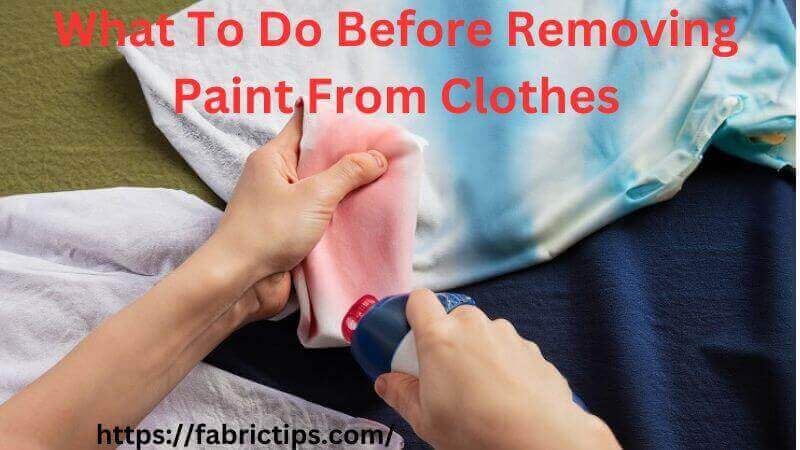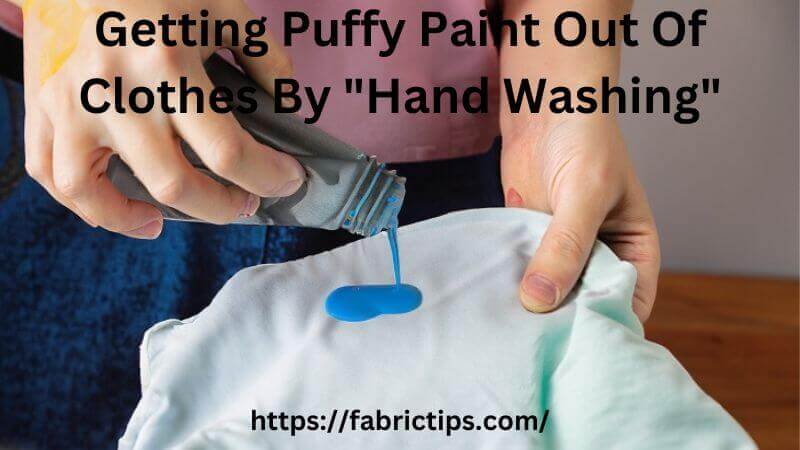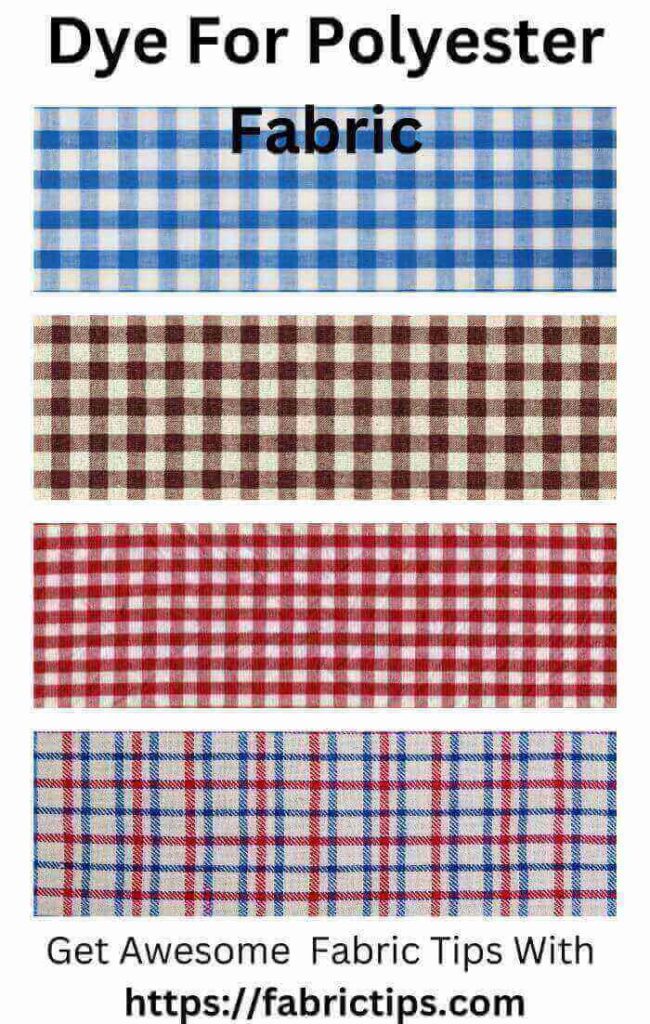Last Updated on December 13, 2025 by Wahid
Fabric paint is great for DIY projects, such as customizing clothes, upholstery, and crafting. However, finding paint on your fabric or carpet after the painting isn’t a pleasant accident, and you should clean it right away.
Find out how to remove fabric paint from clothes, regardless of whether wet paint or dried. Taking off wet paint is much easier than taking off dried paint. Clothing can be washed off with fabric paint if you use the right type and wash it off quickly. Following the pretreatment steps is crucial, as is using the right products for stain removal. By using a few simple techniques, even the most indelible marks can be removed and clothing can be restored to its original splendor.
In the worst case scenario of being unable to wash out paint from fabric, some tricks may help you salvage your clothes. In this article, you will learn how to remove paint from fabric with tricks and methods. Also, we’ll talk about the best ingredients for removing paint from clothes.
What To Do Before Removing Paint From Clothes

Firstly, figure out what sort of paint you’re dealing with. There are two main types of paints, water-based and oil-based, which differ in composition.
- Acrylic & latex paints are water-based paints. Painting with acrylics is common for crafts and artwork, but latex paint is commonly used on walls & ceilings.
- Typically, water-based paints tend to be glossier than oil-based paints & are often used to paint trim, metal, cabinetry, & wood doors, besides walls & ceilings.
- Whenever you’re not sure of the kind of paint you’re handling, make sure it’s labeled or packaged properly.
- In the case of water-based paint, removing it is slightly easier than with oil-based paint. But don’t worry, it is possible to remove oil-based paint from clothing as well.
- You can follow our step-by-step guidelines below for removing both water-based & oil-based colors from your clothing.
Can Fabric Paint Be Washed Off Clothes?

Yes, you can wash fabric paint off your clothes if you take certain factors into account.
- As a result of the heat-setting done by iron or other similar appliances, washing the colors might be more difficult.
- The water-soluble paints, which are also called latex paints, wash off more easily than the water-insoluble ones.
- After water-soluble dye stains have dried, always clean them up and remove any oil-based paints immediately before they dry.
- Whenever silk is mishandled, it can become damaged. Perform a small test to determine whether your treatment method would harm the fabric.
- Additionally, you should determine how long you expect to keep the design or painting on the garment. There are types that can fade faster than others due to the sun or other factors.
- In order to ensure the longevity of your design, you should probably use a permanent solution, which won’t wash off.
- However, if it’s only for fun, you can go ahead and try some temporary or semi-permanent washing techniques – consult the manufacturer before doing so.
How To Remove “Water-Based Paints” From Clothing

Whether it’s painting on the weekend or at school, acrylics paint and latex paint are likely to be used as often as oil-based paints. Despite the kids’ tendency to paint on their paper & clothes, water-based paints can be easily removed. Because unicorn dresses won’t end up in the garbage, you can release a big sigh of comfort now.
Water-based paint can be removed from clothing by following these steps:
Required Supplies
- Paper towel or clean rag
- Warm water
- Removers for stains (optional)
- Detergent
- Rubbing alcohol, non-acetone nail polish remover, or hairspray (optional)
Required Tools
- Dull knife, brush, or spoon
- Washing machine
Step 1: Scrape off any excess paint
Make sure to scrape off all excess dried color as possible with a spoon, dull knife, or brush.
Step 2: Run warm water over the stain
Clean the stain on the backside with a warm water solution. You can also wipe the area with a paper towel or clean rag in order to absorb any remaining paint.
Step 3: Mix detergent with water and saturate spot
To remove the stain, soak it in a mixture of half regular detergent, and half warming water and use a paper towel or rag to vigorously blot it. The paint should disappear and no longer come up after repeated rinsing.
Care tip: Test a hidden, small area of the fabric first to make sure that these agents will not ruin or discolor your fabric.
Step 4: Use stain remover
Stain remover can be applied if needed, and the clothing item should be washed according to the care label instructions.
Step 5: Blot & rewash if stain remains
If any paint appears after washing, gently blot with nail polish remover without acetone, rubbing alcohol, or hairspray, & then rewash. For best results when using these products, make sure the garment is thoroughly rinsed in the washer before use.
Step 6: Dry clean the item
A professional dry cleaner may be able to remove the stain if it is still present.
How To Remove “Oil-Based Paints” From Clothing

Even though most wall paints now use latex, oil-based paint remains prevalent for woodwork, furniture, doors, and flooring that requires a glossy finish. In this case, you might have to use more powerful cleaning agents – plus a bit of elbow grease. However, even if your spouse is sitting on a still-wet bench in the mudroom, it’s not impossible to remove dried paint from his jeans.
Oil-based paint can be removed from clothing by following these steps:
Required Supplies
- Turpentine or paint thinner
- Clean rags or paper towels
- Dishwasher detergent
- Hot water
- Stain remover (it’s optional)
Required Tools
- Washing machine
Step 1: Turn the fabric inside out & wipe the stain away
Make a thick pile of paper towels or clean rags and turn the garment inside out. To remove the stain, use turpentine or paint thinner until the color can no longer hold any more paint.
Care tip: Conduct a spot test on a small, invisible area to make sure that the color thinner doesn’t deteriorate or discolor the textile.
Step 2: Remove stains by rinsing
Warm water should be used to rinse out the stain.
Step 3: Use detergent and let the stain soak
Stain the garment with dishwasher detergent and soak it in hot, detergent-infused water overnight. You can find the recommended water temperature on the product’s care tag.
Step 4: Next day, rinse the garment
Rinse the clothing thoroughly the next day and then rewash it according to your normal washing routine.
Step 5: Rewash with stain remover
Alternatively, if the mark persists after washing, wash the cloth again after treating it with stain remover. Be careful not to dry the fabric before the stain has completely disappeared.
Getting Puffy Paint Out Of Clothes By “Hand Washing”

As opposed to fabric spray paint, puff paint is water-based & more easily removed with soap and warm water. The best way to remove puffy paint from clothes is to hand-wash them with soapy water.
Puffy Paint Cleaner
- Dish soap
- Cool water
- Sponge
Clean the clothing item by laying it on a flat, clean surface, dabbing some liquid dish soap on it, and wiping it down with water and a sponge. The sponge must be rinsed and wrung out thoroughly until the paint is removed, repeating the steps till the stain has disappeared.
Make sure the item is thoroughly rinsed under cool, running water before hanging it to dry. It is essential that all paint is removed before you place the item in the dryer. If you do not, you risk the paint stain setting in.
Remove Fabric Paint From Clothes Using “Hairspray”

After hand-cleaning the fabric, if any paint residue is left on the fabric, spray it with an alcohol-based hairspray. Find out how to remove puffy paint from clothes using hairspray & clean rags.
Clean Fabric Paint Stains with Hairspray
- Hairspray
- Plastic
- Clean rags
When removing puffy paint from clothes, scrape as much paint away as possible with a plastic putty knife. Rub the area with a clean rag after spraying it with hairspray. After a large part of the stain has disappeared, wash the item under running water to remove any paint that remains.
Remove Fabric Paint From Clothes Using “Rubbing Alcohol”

The most common household ingredient we use for sanitizing surfaces and dissolving sticky materials is rubbing alcohol. In addition to removing hair dye from clothes, this disinfectant liquid is also effective for removing fabric paint.
Rubbing Alcohol Fabric Paint Remover
- Rubbing alcohol
- Water
- Cotton balls
As a precaution against paint transferring to your workspace, place a clean towel over the stained fabric. Make sure rubbing alcohol is poured on a cotton ball, and blot it on the dried stain. For removing lipstick from clothing or paint from walls, use a circular motion.
Using fresh cotton, remove the stain until it’s gone, then hold the fabric under running water so that no color is visible. If clothes dye gets on your fingers, use hand sanitizer or rubbing alcohol to clean it. It works perfectly.
Remove Fabric Paint From Clothes Using “Nail Polish Remover”

One of the simplest ways to remove fabric dye from clothing or Sharpies can be removed with fingernail polish remover. Even so, you must apply an acetone-based solvent to remove the paint stain.
Nail Polish Remover for Stains
- Acetone nail polish remover
- Clean cloth
- Towel
- Cold water
On a clean, flat surface, spread a towel and place the colored garment item on it, paint side facing down. Using a fresh cloth, dab the affected area with acetone fingernail polish to minimize the spread of the stain.
Keep using fresh cloths and nail polish thinner throughout the process, rubbing the area in a circular motion. Rinse the clothes under cold running water to remove any remaining paint. A similar method can be used to remove paint from the carpet. Until the stain is lifted, contain it from the outside in.
Remove Fabric Paint From Clothes Using “Washing Machine”

For best results, wash the item in the washer to remove any leftover residue. After you’ve removed the maximum amount of paint with rubbing alcohol, acetone, or paint thinner.
Machine Washing Clothes
- Washing machine
- Paint-stained clothes
- Laundry detergent
- Clothes dryer
Following stain removal with one of the above methods, the clothes should be washed one last time. When washing out tie dye, use your favorite laundry detergent on the stained items. It is best to clean them with cold water.
Keep them away from your other laundry to avoid spreading leftover paint. If the paint stain is still present, do not use hot water. Once the washer has finished its cycle, make sure the stain is removed, and hang the clothes to dry, as you normally would.
Whenever paint is present, repeat the washing cycle to remove the paint before drying the item under heat. Giving clothes a whole new look is easy with a fabric medium. However, accidents can happen, resulting in paint getting on the wrong material. Fortunately, you can maintain the appearance of your clothes by removing clothing paint stains.
How To Get Fabric Paint Out Of “Carpet & Upholstery”

Obviously, painting isn’t the only process that happens accidentally. The paint even spilled onto the carpet and upholstery. In order to fix that, we used the following steps:
Step 1: Scrape off any excess paint
The first step, you should do is remove the excess paint from the upholstery & carpet when you accidentally spill paint on them. To get started, you’d better grab a sponge or rag right away. Do a slow dab with that and apply it to the surface. The surface should be soaked in excess paint.
Step 2: Mix detergent & water together
Then, after the uppermost layers of paint have been removed, a cleaning solution must be prepared. To do this, you will need water & detergent. It is recommended to use mild detergents so that the fabric doesn’t get discolored or ruined.
Thus, based on how severe the spill was, a suitable amount of detergent and water would be needed. To clean small to mid-sized spills, combine 2 cups of water and 1 teaspoon of detergent. Make sure the solution is well blended, close the lid to the jar, and shake it vigorously.
Step 3: Clean the surface
Dip a dry cloth into the cleaning solution once the solution is ready. To remove stains, blot them with the soaked cloth. Be careful not to apply too much force when scrubbing the carpet, as that will cause it to absorb detergent. It will also be necessary for you to be aware of this.
Instead, wipe the affected area gently with the cloth and drag it across it. The stains should look light after repeating the process. The cleaning process shouldn’t take too long, and when you’re done, dry the affected area with a hairdryer.
How To Get Fabric Paint Out Of “Shoes”

If paint spills on your shoes, use a paper towel to wipe it off. When the shoe is cleaned, there will still be some debris or stain. However, don’t worry, we’ll explain how it’s done. Here are the steps you need to follow:
Step 1: Remove Excess Paint
To begin, remove extra paint from the surface by brushing it off. Be sure to choose a brush with bristles that aren’t too soft or hard. However, be careful not to use excessive force, or else your shoe might get scratched.
Step 2: Use a soapy solution
Next, mix one part water with one part detergent and prepare a solution. Use a clean, wet cloth to wipe away the mixture. Dab the surface & gently wipe it with the cloth. As a result, the paint will break down and become scrapable.
Step 3: Scrub off the softened stain
Try getting a dull knife or a tool with a dull edge. To remove paint off the shoes, use that scraper. Scraping will remove a large amount of dye. Nevertheless, a light coating of paint will still remain.
Step 4: Finish Touches
In this step, you will use the solution of detergent you prepared in step 2. Using the dampened cloth, wipe the surface clean. The cloth should be run over the surface. Then, rinse under running water. Make sure the residue is removed by repeating the process.
Last but not least, you will need to brush the affected area with nail polish remover. As a result, no residue will remain.
Getting Paint Off Clothes: Tips And Tricks
From polyester to cotton, it’s possible to remove paint-stains from garments with a bit of time and effort. Whether you’ve stained your favorite pair of jeans or your best button-down shirt, keep the following tips in mind before tackling a paint spill.
- The stain can become more difficult to remove if it is allowed to air dry, which is why you should act quickly.
- Additionally, avoid drying the garment before treating, due to the heat setting the stain.
- If the mark is difficult to remove, blot it with a gentle motion, rubbing will cause it to spread & worsen.
- You should always check the care instructions on the item’s label before cleaning or washing it.
- Be persistent. Multiple treatments may be necessary to remove stubborn paint stains.
What Products Remove Dried Paint From Clothes?

Many common household products are available that can be used to remove stubborn paint marks. The most common of these are baking soda, vinegar, & hydrogen peroxide. When using these products on a paint stain, always try them in a hidden spot first.
It is common to use these cleaners as household laundry solutions for removing stains from clothes. However, you should always check the care label before treating delicate items.
Regarding stain removal, just a little creativity can go a long way. Prior to washing or drying the garment, thoroughly rinse it to protect the fabric. Wash shoes in your washer when you’re dealing with other tough washing tasks.
Warnings: Removing Fabric Paint
- Acetone can damage plastics, as well as acrylic, which is why it shouldn’t be applied to acrylic fabric.
- If you are not sure whether a chemical is safe to use, test it on an invisible part of the item before using it.
- Protect your hands from burns and irritation by wearing rubber gloves.
- Make sure the area is ventilated and doors are open so that chemical fumes cannot be inhaled.
When Nothing Is Working
Once you’ve tried all of the suggestions and the fabric paint spills persist, you may need to hire a professional cleaner. Certain fabrics may be impossible to completely remove stains from.
- Consider covering or disguising the stain instead of throwing it out. An applique or patch that is creative could work.
- Color variation can be used in hand-embroidered designs. The area could also be covered with fabric paint, don’t despair.
- If paint spills onto the long sleeves, you might want to consider short sleeves for the top. If paint spills around the bottom of the pants legs, the same solution will work.
- It is also possible to cover a permanent stain in a more fashionable way, for instance with a scarf or vest in a bright color.
- Even if the piece cannot be recovered, reuse any recoverable textile in other crafts, artworks, or sewing projects.
FAQs
01. Is fabric paint washable?
Definitely, fabric paint can be machine washed once dry and is permanent. Whenever you are painting fabric with fabric paint, ensure your working area and surface are covered with protective material. Additionally, you should avoid painting other fabrics you don’t plan to paint, including carpets and clothing.
02. Are all fabric paints permanent?
Fabric paint is usually permanent and will last for a very long time on your project. Even so, make sure your paint remains on your fabric for as long as you want. When painting something permanent, use machine-washable paint. As a result, it will not peel or fade when washed.
03. What cleans fabric paint?
Rubbing alcohol, mineral spirits, and turpentine are all excellent solvents used with acrylic paint. For a quick fix, if none of these removers are on hand, use nail polish remover based on acetone, or simply hairspray, preferably containing alcohol.
04. Can fabric paint melt?
When the temperature reaches 100 °F (38 °C), the paint may melt and fail to dry, causing the design to be ruined. A high temperature is beneficial to the drying procedure, but excessive heat should not be used.
05. Can I soak clothes in vinegar overnight?
If using it, let the stained item soak for 30 minutes or overnight with a solution that contains white vinegar & 1 Tbsp liquid laundry detergent before laundering. White vinegar can also be effective when it comes to removing mildew and mold from fabrics.
06. Which is better: fabric paint or acrylic paint?
Fabric paint differs from acrylic paint in many ways, namely, that acrylic paint offers a thick consistency, in contrast, fabric paint lacks a thick consistency. Therefore, acrylic paints tend to last longer than fabric paints.
07. How do you remove dried acrylic paint?
Denatured alcohol is recommended, which is the best solution for dried acrylic stains. Use a cotton ball or cloth to apply the solution and rub against the stained area for about a minute. You can lift the paint by rubbing it in small circular motions. To remove alcohol, wipe the marked area with a wet, soapy washcloth.
08. How do you remove paint without damaging stains?
You can try dish soap & warm water, or use nail polish remover with a tissue, applying gentle pressure to loosen the paint. Wet or dry spots can both be treated with this method. Olive oil can be used on particularly delicate surfaces.
09. What removes washable paint from clothes?
Using hot water, add laundry detergent and wash for 12 minutes on a heavy soil cycle. Dry the garment only on low heat. After one hour, soak the container in Oxi Clean or Clorox 2 solution as directed on the container.
10. How do you get paint out of clothes in 5 minutes?
Salt, vinegar, and ammonia. These 3 household staples will get paint off clothes. The mixture should consist of 2 tablespoons of vinegar, 1 tablespoon of salt, and 2 tablespoons of ammonia. If necessary, soak a rag or used toothbrush in the mixture, and scrub the discoloration until it is removed.
Conclusion
Hopefully, you will consider our suggestions on how to remove fabric paint from clothes & this article will save you from fabric disasters in the future. Basically, painting fabric can be a fun hobby until the paint smears on your gorgeous clothes. However, you can get fabric paint out of your fabric in a variety of convenient ways. In my list, I have listed some of the most dependable ones you can rely on.
Finally, be sure to share your reading experience with your family and friends if you enjoyed it.


